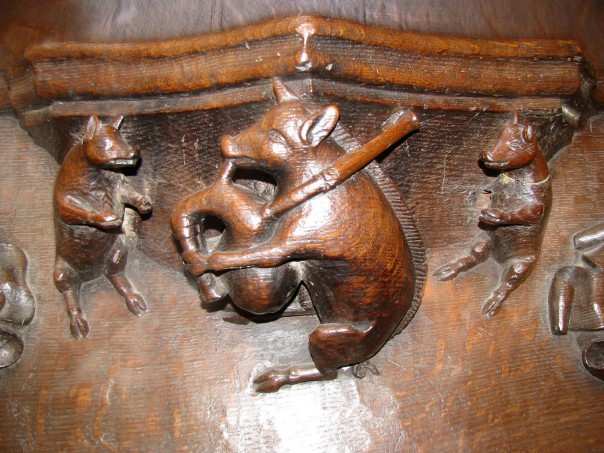Apologies to those, if there are any, who wondered what had happened this week but I wanted to wait until after the London Medieval Society conference that took place yesterday.
This took place in London off Charterhouse Square and featured two speakers from the Centre. Indeed, the whole event was organised by Dr Diane Heath, a Research Fellow in the Centre, as her swansong. She has been the conference secretary for LMS for the last six years and is stepping down to give herself more time to write one if not two books from her doctoral thesis, among other things. Her speciality, as some of you will know, is the bestiary and its place in medieval culture, consequently it was fitting that her final one-day conference was entitled ‘Animals in Medieval Culture’. Among the appreciative audience was Professor Barron, who is Patron of the Society. Caroline Barron, as a well-known expert on medieval London, will be speaking at the Canterbury Medieval Weekend at Canterbury Christ Church between 6-8 April 2018 – not to be missed!
However, to return to yesterday’s proceedings, the first speaker was Dr Patricia Stewart, who studied the Latin Bestiary for her doctoral thesis at St Andrew’s University and who now works as a researcher for the Oxford English Dictionary where she specializes in words relating to flora and fauna. Her paper yesterday on ‘Defining medieval beasts’ was an excellent place to start the day. Patricia began by examining how and why bestiaries and their forerunners were compiled, explaining their importance for contemporaries as exempla for humans through the symbolic value placed on animals as understood using biblical exegesis. Thus, she noted the great weight placed on etymology as a means to understand nature and the scriptures, and ultimately to try to comprehend the nature of God, allowing that humans are by definition fallible and unable to understand fully.
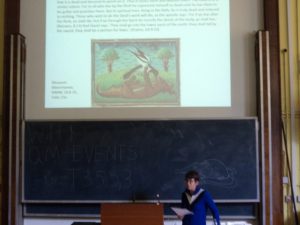
Dr Patricia Stewart explores the bestiary fox
Having provided a couple of examples to demonstrate how this was done, Patricia moved on to discuss the early medieval dictionaries of the 12th and 13th centuries, and how through the medieval desire for order in God’s universe the first dictionaries were not arranged alphabetically but rather, for example, by room if defining words associated with dwellings. At a result, some of these early dictionaries had indexes, which rather defeated the purpose! As she pointed out, the development of the dictionaries to arrange words alphabetically with respect to all the letters in a word did not take place systematically. Yet in broad terms, this shift did happen over time, and of particular interest is John Balbi’s Catholicon, this Italian grammarian and Dominican priest dying c.1298. Balbi’s extensive work is especially important because as well as discussing the meaning of words, including those for specific animals, he added points on grammar and drew on earlier works as well as cross-referencing his sources. Furthermore, unlike the bestiaries, moralization in terms of what animals mean was not his concern, rather he provided some what we might call ‘facts’ about the physicality of the animal concerned. Such ideas about knowledge through words continued to be valued by late medieval scholars, these dictionaries to be found in universities and used by preachers, and, although some Renaissance humanists mocked Balbi’s work, it was one of the first books to be printed in 1460, two further editions appearing soon after, using a press of the type employed by Gutenberg. Patricia then discussed modern dictionaries, but I’ll leave it here and move on to the second paper.
Diane’s paper on the deployment of the scarlet phoenix in the earliest known Latin bestiary and the sermon collection of Honorius Augustodunensis, Speculum Ecclesiae offered a fascinating close reading of texts, manuscript illustrations, and animal stone carvings (as seen on the crypt capitals of Canterbury Cathedral), as well as a possible wall painting in the Corona chapel (part of the rebuilding following the second of the post-Conquest fires at Canterbury Cathedral). To unpack this fascinating case study for the blog that in many ways centres on St Anselm’s ideas about spirituality and pastoral care, I shall need to simplify and abridge many of Diane’s analytical points. However, I hope she will publish the full version because it seems to me to be an important contribution to our understanding of early 12th-century theology and the place of the laity in the history of the Church.
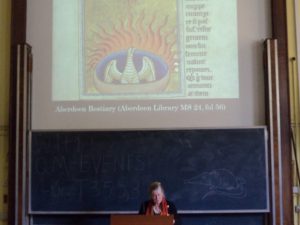
Another fantastic phoenix
So what were the key points put forward by Diane? Firstly that this earliest of bestiaries, now Bodleian Library, Oxford, Laud Misc. 247, can be assigned an earlier date than previously thought and is highly likely to have been produced at Christchurch, that is at Canterbury Cathedral Priory around 1100. For rather than it being a bestiary per se, Diane sees it as a history book within which one of the texts provides material about certain animals, including the phoenix. This material draws on etymology, biblical references and, to a limited extent, physical features, the point being to set the phoenix, and any other beast, with respect to the four fold senses of its literal, allegorical, moral and anagogical (spiritual) meanings. Thus, as Patricia had said, animals acted as examples and, the phoenix, working as an allegory was seen as representing Christ, the crucial characteristics being that it lives forever, does not have sex, and, vitally, it kills itself and yet is restored to life. These characteristics make it, therefore, ideal as an exemplum of Christ in the context of an Easter sermon.
This brings us to another point, the placing of Honorius’ Speculum Ecclesiae in terms of its production and consumption. The critical issues here being the dating and identity of its intended audience. Again, Diane drew on a range of sources for her analysis. Yet the important points here are that she believes it post-dates the Bodleian manuscript, it is likely that Honorius on his various travels had been to Canterbury and had seen this manuscript and that in responding to a request from Anselm or his senior monks, he used material with which they would have been familiar. Now the request revolved around Anselm’s desire to enhance the spiritual lives of the laity – laypeople should be encouraged to hear sermons on the most important liturgical days in great churches and cathedrals, given by monastic brethren.
Diane then showed how Honorius fulfilled this request. The Speculum comprises sermons in Latin couplets of about a hundred thousand words in total, which were designed to appeal to the laity as well as the monks, intention being that the sermons should be given in English. As Honorius writes ‘With respect to all the sermons, you should first say the line in Latin, then explain in the local language’. Furthermore, and here we have another of Diane’s key points, Honorius made it clear that the sermons and the animals within them were linked to the adornment of the Cathedral. You remember the crypt capitals I mentioned earlier; well these were part of Anselm’s rebuilding programme. Those stone carvings, and the now lost stained glass and probably other adornment in Lanfranc’s nave, a slightly earlier part of the cathedral rebuilding programme following the disastrous fire of 1067, together feasibly represent what Honorius was referring to. Now, even though the crypt capitals were presumably created for a monastic audience, the crypt being a sacred space, the animals in the nave would have been seen by laypeople as they gathered to hear sermons at Christmas, and crucially for the phoenix as exemplum, Easter Sunday. Thus aural pictures in the sermon echoed visual pictures in the nave. Consequently, this cross-fertilization of text and image for multiple audiences to understand at various intellectual and spiritual levels made this paper significant, because it opens up the micro to the macro, providing relevance that goes far beyond Canterbury in the early 12th century.
Dr Bob Mills similarly employed a microhistory approach to his discussion of Matthew Paris’ depictions in his Chronica majora of Henry III’s elephant, a gift from Louis IX of France. In his exploration of sovereignty and its counterpoint thraldom, Bob, who is a Reader in Art History at UCL, divided his paper into four sections: political animals as gifts; collecting animals, Chronica majora as wunderkammer; keeping animals, literally and metaphorically, and movement and stasis, Matthew Paris, the elephant and the politics of ‘life’. Among the issues he considered in his first section were animal gifts as diplomatic currency, which could highlight different power relationships between donor and recipient depending on the type of animal and the specifics of the donation. Moreover, Bob saw Matthew taking a role in such ongoing relationships through the way he had drawn the elephant, as well as how he had included his drawing and text about the beast with material about historic events, the nature of towns and other apparently very different matter.
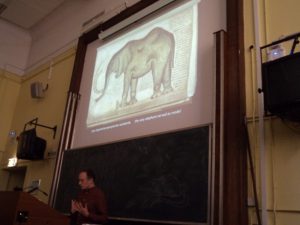
Dr Bob Mills and Henry III’s elephant
Bob’s second and third sections covered the ideas of collecting as linked to signs of sovereignty when such collecting was of the exotic, even magical, and the sense of the formation of sacred repositories. These might include saints’ relics, but equally ‘objects of wonder’, such as the poor elephant’s bones that Henry III decreed should be dug up from the Tower and given to Westminster Abbey. Such wondrous matter offered ideas about kingship, but Bob sought to explore this further in terms of what happens when this is transformed into the miniature drawings in Matthew’s text. Such considerations led him to the keeping of animals – from the menagerie at the Tower to depictions of animals in paintings, and how possession was equally involved in both instances. Furthermore, he also discussed ‘keeping’ in terms of knowledge and how this, too, related to power relations between producer and consumer, creator and audience.
Moving to his final point, Bob sought to argue against the idea that Matthew’s depictions should be considered journalistic. For, even though Matthew could indeed have seen the elephant, the creation of life drawing was not the point. As an educated monk, Matthew would have been steeped in biblical and classical ideas about animals and the relationships between God and Creation and between man and the animals, all of which would have fed in to his portrayal of Henry’s elephant. This was another fascinating paper on the ideas of the elite – clerics and lay – regarding exotic animals, thereby demonstrating the richness of animal imagery within medieval culture.
Moving away from these elite humans and animals, my paper considered that ubiquitous animal in medieval society, the pig. ‘Rethinking the medieval pig’ offered a very fruitful topic because even though superficially most people might think it was solely a much, maligned animal in the Middle Ages, the picture is more complex. I do not have space to go into more than one brief example here, but in simple terms pigs were seen as ‘good’, ‘bad’ and somewhat ambiguously. My example is the bagpipe-playing pig, and John Thompson’s essay in Everyday Objects, ed. T. Hamling and C. Richardson was my starting point. In this essay, he takes what he called the ‘everyday’ bagpipes, that is an object often depicted in mundane circumstances or one symbolically seen as representing normality, and explored its cultural meanings in the very particular elite circumstances of Richard II’s court. For he believes bagpipes have the potential to reveal ideas about the later years of the 14th century regarding harmony and disharmony, concordance and discordance, and, most particularly, conformity and non-conformity. Because bagpipes – like pigs – were capable of being seen in contradictory ways, thus, as he says, we have on the one hand the vulgarity of unpleasant noises linked to the rural peasant, to animal crudeness, the shape reminiscent of a distended stomach thereby linking it to gluttony and lechery. Conversely, he notes bagpipes were associated with divine order and angelic harmony, with Nativity scenes and pastoral innocence. He also discusses their value in terms of unity of purpose and mutual help during pilgrimage, for example, pilgrims playing and singing to bring the company together. In this he is thinking about Archbishop Arundel’s ideas and Chaucer’s Miller, who leads the pilgrims out of Southwark as he plays the bagpipes, the latter depiction Thompson sees paralleling the many royal progresses of the later Middle Ages. For such musical instruments, often in conjunction with trumpets were common at royal entries into towns. They were similarly used during civic processions, such as the Corpus Christi pageants, or during other quasi-religious rituals, and many towns had their own waites or civic musicians. Looking at manuscript illustrations, he sees the bagpipe player as potentially representing Everyman or the Commons in terms of obedience to royalty.
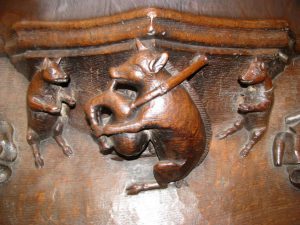
Pig-piper and dancing pigs: Ripon (photo Imogen Corrigan).
Thompson stops at this point, but what about the pig as piper? Are the representations that survive, admittedly almost all on misericords, symbols of a world turned upside down, as a negative interpretation of the sow as musician, or are they similarly open to conflicting interpretations? For example, is the apparently strong maternal bond valued, as at Winchester Cathedral where the piglets suck from the sow’s teats as she continues to play? Furthermore, the sow playing at a funeral on a misericord at Manchester cathedral has the potential to echo civic/religious processions, the pigs perhaps in this case acting as mourners. Moving away from misericords, one pig piper from the rood screen at Ribbesford, Worcestershire, is surrounded by acorns, his playing accompanying the act of eating in the side panels, which will bring prosperity to the pig in the short term and man in the longer term as all benefit from God’s harvest. Yet, uncomfortably perhaps, this needs to be set against the man playing the pig bagpipes at Beverley.
Following this final paper, there was a short discussion. The audience, as well as the speakers, considered the idea of animality, in both medieval and modern contexts, as well as whether there were significant differences between elite and popular experiences and thus understanding of animals in medieval culture. After this, Diane was thanked for all her work on the Society’s behalf, the conference concluding with its traditional wine reception where discussions continued – a mark of a very successful day.
 Centre for Kent History and Heritage
Centre for Kent History and Heritage Sheila Sweetinburgh
Sheila Sweetinburgh 1700
1700